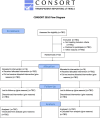The effectiveness of Bio-Min toothpaste in the management of white spot lesions: a randomised control trial
- PMID: 39256875
- PMCID: PMC11388904
- DOI: 10.1186/s13063-024-07990-5
The effectiveness of Bio-Min toothpaste in the management of white spot lesions: a randomised control trial
Abstract
Background: White spot lesions (WSL) are common side effects of orthodontic treatment with fixed appliances, in which the surface layer of enamel is demineralised. Thus, remineralisation, that is a partial or complete reversal, of these lesions can occur as they affect the surface enamel. Remineralisation with low-dose fluoride, in addition to optimal oral hygiene and diet, has been recommended to manage WSL. The aim of the planned trial is to assess the effectiveness of a fluoride-containing bioactive glass toothpaste (BioMin™) in its ability to remineralise post-orthodontic demineralised WSL.
Methods: A single-centre, double-blind randomised clinical trial to assess intervention with Bio-Min toothpaste on WSL forming on the teeth of young people completing orthodontic treatment.
Discussion: Remineralisation of WSL can vary depending on the individual and the site of the lesion. There is a range of oral fluoride delivery methods which include toothpastes, oral rinses, and gel preparations, which can aid remineralisation of these lesions. Identifying effective methods of remineralisation to manage this common and unsightly complication of fixed appliance therapy can improve the health and aesthetics of dentition.
Trial registration: ISRCTN.com International Standard Randomised Controlled Trials Number (ISRCTN) 14479893 . Registered on 14 May 2020.
Keywords: Bio-Min toothpaste; Fixed appliance treatment; Remineralisation; White spot lesion.
© 2024. Crown.
Conflict of interest statement
The authors declare that they have no competing interests.
Figures
Similar articles
-
DIAGNOdent pen quantification of the synergy of NovaMin® in fluoride toothpaste to remineralize white spot lesions in patients with fixed orthodontic appliances: A double-blind, randomized, controlled clinical trial.Int Orthod. 2022 Jun;20(2):100632. doi: 10.1016/j.ortho.2022.100632. Epub 2022 Apr 12. Int Orthod. 2022. PMID: 35428577 Clinical Trial.
-
Fluorides for preventing early tooth decay (demineralised lesions) during fixed brace treatment.Cochrane Database Syst Rev. 2019 Nov 17;2019(11):CD003809. doi: 10.1002/14651858.CD003809.pub4. Cochrane Database Syst Rev. 2019. PMID: 31742669 Free PMC article.
-
A randomised clinical study to evaluate experimental children's toothpastes in an in-situ palatal caries model in children aged 11-14 years.Int Dent J. 2013 Dec;63 Suppl 2(Suppl 2):31-8. doi: 10.1111/idj.12073. Int Dent J. 2013. PMID: 24283282 Free PMC article. Clinical Trial.
-
In vitro assessment of a toothpaste range specifically designed for children.Int Dent J. 2013 Dec;63 Suppl 2(Suppl 2):48-56. doi: 10.1111/idj.12071. Int Dent J. 2013. PMID: 24283284 Free PMC article.
-
Enamel remineralization therapies for treating postorthodontic white-spot lesions: A systematic review.J Am Dent Assoc. 2018 Sep;149(9):778-786.e2. doi: 10.1016/j.adaj.2018.05.010. Epub 2018 Jul 12. J Am Dent Assoc. 2018. PMID: 30007454
References
-
- Chapman JA, Roberts WE, Eckert GJ, Kulu KS, Gonzalez-Cabezas C. Risk factors for incidence and severity of white spot lesions during treatment with fixed orthodontic appliances. Am J Orthod Dentofac Orthodont. 2010;138(2):188–94. 10.1016/j.ajodo.2008.10.019.10.1016/j.ajodo.2008.10.019 - DOI - PubMed
-
- Shungin D, Olsson AL, Persson M. Orthodontic treatment-related white spot lesions: a 14-year prospective quantitative follow-up, including bonding material assessment. Am J Orthod Dentofac Orthodont. 2010;138(2):136.e1–8. 10.1016/j.ajodo.2009.05.020. discussion 136–7.10.1016/j.ajodo.2009.05.020 - DOI - PubMed
Publication types
MeSH terms
Substances
LinkOut - more resources
Full Text Sources



